Role Serial Killer Name H. Holmes | Span of killings 1888?–1894 Criminal penalty Death | |
Full Name Herman Webster Mudgett Born May 16, 1861 ( 1861-05-16 ) Gilmanton, New Hampshire, U.S. Other names Henry W. Howard
Dr. Henry Howard Holmes
Henry Gordon
Alexander Bond Conviction(s) four counts of murder in the first degree
six counts of attempted murder Victims 9–200 (9 confirmed, 27 confessed, up to 200 estimated) Died May 7, 1896, Moyamensing Prison Buried May 8, 1896, Holy Cross Cemetery Children Lucy Theodate Holmes, Robert Lovering Mudgett Spouse Georgiana Yoke (m. 1894–1896), Myrta Z. Belknap (m. 1887–1896), Clara A. Lovering (m. 1878–1891) Parents Levi Horton Mudgett, Theodate Page Price Similar People Erik Larson, Jack the Ripper, Daniel Burnham, Albert Fish, John Wayne Gacy | ||
Cause of death Execution by hanging | ||
H. H. Holmes | Mini Series #9
Herman Webster Mudgett (May 16, 1861 – May 7, 1896), better known under the name of Dr. Henry Howard Holmes or more commonly H. H. Holmes, was an American serial killer of the 19th century.
Contents
- H H Holmes Mini Series 9
- Early life
- Illinois and the Murder Castle
- First murders
- Capture and arrest
- Media
- References

While he confessed to 27 murders, only nine could be plausibly confirmed and several of the people whom he claimed to have murdered were still alive. He is commonly said to have killed as many as 200, though this figure is traceable only to 1940s pulp magazines. Many victims were said to have been killed in a mixed-use building he owned, located about 3 miles (4.8 km) west of the 1893 World's Fair: Columbian Exposition, supposedly called World's Fair Hotel (informally "The Murder Hotel"), though evidence suggests that the hotel portion was never truly open for business.
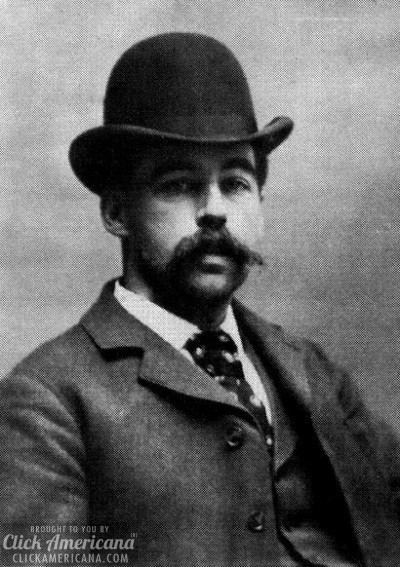
Besides being a serial killer, Holmes was also a con artist and a bigamist, the subject of more than 50 lawsuits in Chicago alone. Many now-common stories of his crimes sprang from fictional accounts that later authors took for fact; however, in a 2017 biography, Adam Selzer wrote that Holmes' story is "effectively a new American tall tale – and, like all the best tall tales, it sprang from a kernel of truth".
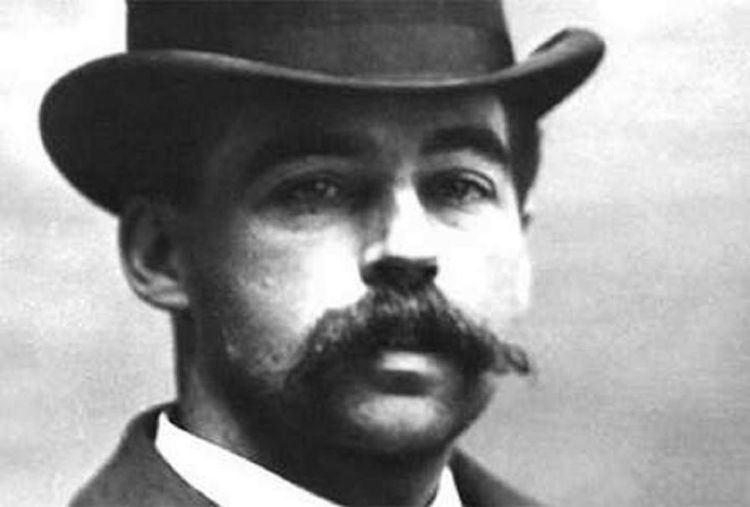
H. H. Holmes was executed on May 7, 1896, for the murder of friend and accomplice Benjamin Pitezel. During his murder trial for Pitezel, H. H. Holmes confessed to numerous other killings.

Early life
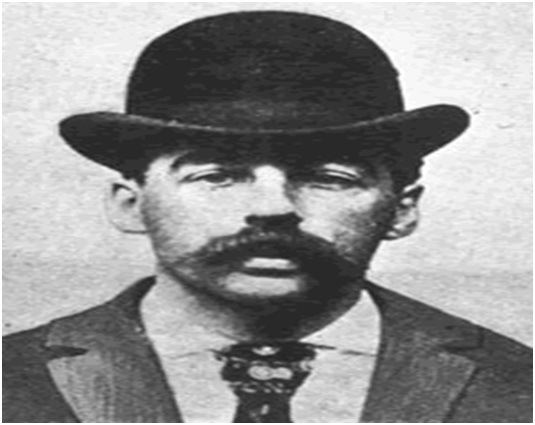
Holmes was born as Herman Webster Mudgett in Gilmanton, New Hampshire, on May 16 1861, to Levi Horton Mudgett and Theodate Page Price, both of whom were descended from the first English settlers in the area. Mudgett was his parents' third-born child; he had an older sister Ellen, an older brother Arthur, a younger brother Henry and a younger sister Mary. Holmes's father was from a farming family, and at times he worked as a farmer, trader and house painter; his parents were devout Methodists. Later attempts to fit Holmes into the patterns seen in modern serial killers have described him torturing animals and suffering from abuse at the hands of a violent father, but contemporary and eyewitness accounts of his childhood showed no traces of them.
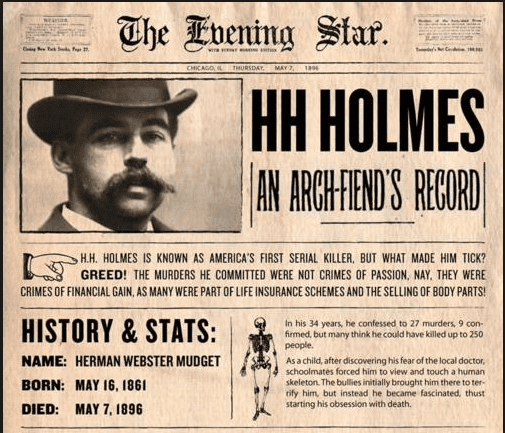
At the age of 16, Holmes graduated from high school and took teaching jobs in Gilmanton and later in nearby Alton. On July 4, 1878, he married Clara Lovering in Alton; their son, Robert Lovering Mudgett, was born on February 3, 1880, in Loudon, New Hampshire. As an adult, Robert became a certified public accountant, and served as city manager of Orlando, Florida.

Holmes enrolled in the University of Vermont in Burlington at age 18, but was dissatisfied with the school and left after only one year. In 1882, he entered the University of Michigan's Department of Medicine and Surgery and graduated in June 1884 after passing his examinations. While enrolled, he worked in the anatomy lab under Professor Herdman, then the chief anatomy instructor. Holmes had previously apprenticed in New Hampshire under Dr. Nahum Wight, a noted advocate of human dissection. Years later, when Holmes was suspected of murder and claimed to be nothing but an insurance fraudster, he admitted to using cadavers to defraud life insurance companies several times in college.
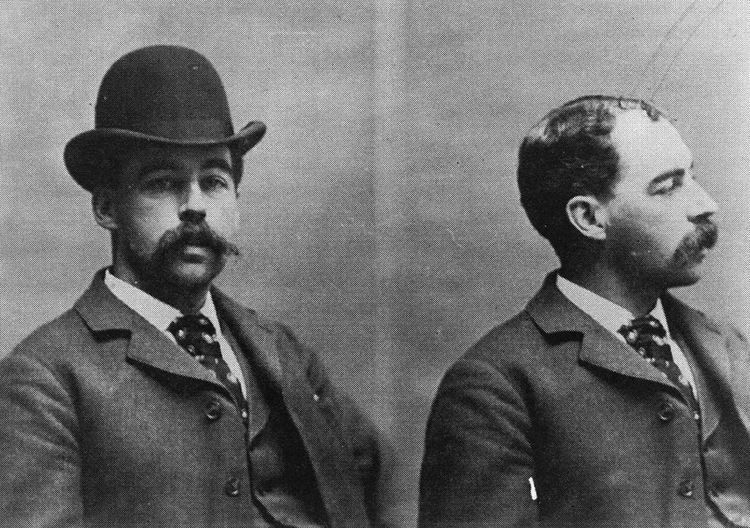
Housemates described Holmes as treating Clara violently, and in 1884, before his graduation, she moved back to New Hampshire and later wrote that she knew little of him afterwards. After he moved to Mooers Forks, New York, a rumor spread that Holmes had been seen with a little boy who later disappeared. Holmes claimed the boy went back to his home in Massachusetts. No investigation took place and Holmes quickly left town. He later traveled to Philadelphia and eventually got a job as a keeper at Norristown State Hospital, but quit after a few days. Subsequently, he got a position at a drugstore in Philadelphia, but while he was working there, a boy died after taking medicine that was purchased at the store. Holmes denied any involvement in the child's death and he immediately left the city. Right before moving to Chicago, he decided to change his name to Henry Howard Holmes in order to avoid the possibility of being exposed by victims of his previous scams. In his confession following his arrest, Holmes claimed that he had killed his former medical school classmate, Dr. Robert Leacock, in 1886 for insurance money; Dr. Leacock, however, died in Watford, Ontario in Canada on October 5, 1889. In late 1886, while he was still married to Clara, Holmes married Myrta Belknap (b. October 1862 in Pennsylvania) in Minneapolis, Minnesota. He filed for divorce from Clara a few weeks after marrying Myrta, alleging infidelity on her part, but the claims could not be proven and the suit went nowhere. Surviving paperwork indicated that she probably was never even informed of the suit. In any case the divorce was never finalized; it was dismissed June 4, 1891, on the grounds of "want of prosecution". Holmes had a daughter with Myrta, Lucy Theodate Holmes, who was born on July 4, 1889, in Englewood, Chicago; as an adult, Lucy became a public schoolteacher. Holmes lived with Myrta and Lucy in Wilmette, Illinois, and spent most of his time in Chicago tending to business. Holmes married Georgiana Yoke on January 17, 1894, in Denver, Colorado, while still married to both Clara and Myrta.
Illinois and the "Murder Castle"
Holmes arrived in Chicago in August 1886 and came across Elizabeth S. Holton's drugstore at the southwest corner of South Wallace Avenue and West 63rd Street in Englewood. Holton gave Holmes a job, and he proved himself to be a hardworking employee, eventually buying the store. Although several books portray Holton's husband as an old man who quickly vanished along with his wife, Dr. Holton was actually a fellow Michigan alumnus, only a few years older than Holmes, and both Holtons remained in Englewood throughout Holmes' life and survived well into the 20th century; the idea that Holmes killed them is strictly fiction.
Holmes purchased an empty lot across from the drugstore, where construction began in 1887 for a two story mixed-use building, with apartments on the second floor and retail spaces, including a new drugstore, on the first. When Holmes declined to pay the architects or the steel company, Aetna Iron and Steel, they sued in 1888. In 1892, he added a third floor, telling investors and suppliers that he intended to use it as a hotel during the upcoming World's Columbian Exposition, though the hotel portion was never completed. Furniture suppliers found that Holmes was hiding their materials, for which he had never paid, in hidden rooms and passages throughout the building. Their search made the news, and investors for the planned hotel pulled out of the deal when a jeweler in the building showed them the articles. When the third floor caught fire on the night of August 13, 1893, only a few people were in the building, all employees and long term residents. Holmes had taken out insurance policies on the building with at least four companies, all of which promptly sued rather than pay.
First murders
One of Holmes' early murder victims was his mistress, Julia Smythe. She was the wife of Alex Conner, who had moved into Holmes' building and began working at his pharmacy's jewelry counter. After Conner found out about Smythe's affair with Holmes, he quit his job and moved away, leaving Smythe and her daughter Pearl behind. Smythe gained custody of Pearl and remained at the hotel, continuing her relationship with Holmes. Julia and Pearl disappeared on Christmas of 1891, and Holmes later claimed that she had died during an abortion, though what truly happened to the two was never confirmed. Another likely Holmes paramour, Emeline Cigrande, began working in the building in May 1892, and disappeared that December. Edna Van Tassel, who "vanished", is also believed to have been one of Holmes' victims.
While working in the Chemical Bank building on Dearborn Street, Holmes met and became close friends with Benjamin Pitezel, a carpenter with a criminal past who was exhibiting, in the same building, a coal bin which he had invented. Holmes used Pitezel as his right-hand man for several criminal schemes; a district attorney later described Pitezel as "Holmes' tool ... his creature". In early 1893, a one-time actress named Minnie Williams moved to Chicago; Holmes claimed to have met her in an employment office, though there were rumors that he had met her in Boston years earlier. He offered her a job at the hotel as his personal stenographer, and she accepted. Holmes was able to persuade Williams to transfer the deed to her property in Fort Worth, Texas, to a man named Alexander Bond (an alias of Holmes). In April 1893, Williams transferred the deed, with Holmes serving as the notary (Holmes later signed the deed over to Pitezel, giving him the alias "Benton T. Lyman"). The next month, Holmes and Williams, presenting themselves as man and wife, rented an apartment in Chicago's Lincoln Park. Minnie's sister, Nannie, came to visit, and in July, she wrote to her aunt that she planned to accompany "Brother Harry" to Europe. Neither Minnie nor Nannie was seen alive after July 5, 1893.
Capture and arrest
With insurance companies pressing to prosecute Holmes for arson, Holmes left Chicago in July 1894. He reappeared in Fort Worth, where he had inherited property from the Williams sisters. There, he sought to construct another "castle" along the lines of his Chicago operation, once again swindling a number of suppliers.
In July 1894, Holmes was arrested and briefly incarcerated for the first time, on the charge of selling mortgaged goods in St. Louis, Missouri. He was promptly bailed out, but while in jail he struck up a conversation with a convicted outlaw named Marion Hedgepeth, who was serving a 25-year sentence. Holmes had concocted a plan to swindle an insurance company out of $10,000 by taking out a policy on himself and then faking his death. Holmes promised Hedgepeth a $500 commission in exchange for the name of a lawyer who could be trusted. Holmes was directed to a young St. Louis attorney named Jeptha Howe. Howe was in practice with his older brother, Alphonso Howe, who had no involvement with Holmes or Pitezel or their fraudulent activities. Jeptha Howe, however, found Holmes' scheme brilliant. Nevertheless, Holmes' plan to fake his own death failed when the insurance company became suspicious and refused to pay. Holmes did not press the claim; instead, he concocted a similar plan with Pitezel.
Pitezel agreed to fake his own death so that his wife could collect on a $10,000 life insurance policy, which she was to split with Holmes and Jeptha Howe. The scheme, which was to take place in Philadelphia, called for Pitezel to set himself up as an inventor under the name B.F. Perry, and then be killed and disfigured in a lab explosion. Holmes was to find an appropriate cadaver to play the role of Pitezel. Instead, Holmes killed Pitezel by knocking him unconscious with chloroform and setting his body on fire with the use of benzene. In his confession, Holmes implied that Pitezel was still alive after he used the chloroform on him, prior to being set on fire. However, forensic evidence presented at Holmes' later trial showed that chloroform had been administered after Pitezel's death (a fact which the insurance company was unaware of), presumably to fake suicide in order to exonerate Holmes should he be charged with murder.
Holmes proceeded to collect the insurance payout on the basis of the genuine Pitezel corpse. Holmes then went on to manipulate Pitezel's unsuspecting wife into allowing three of her five children (Alice, Nellie and Howard) to be in his custody. The eldest daughter and the baby remained with Mrs. Pitezel. Holmes and the three Pitezel children traveled throughout the northern United States and into Canada. Simultaneously, he escorted Mrs. Pitezel along a parallel route, all the while using various aliases and lying to Mrs. Pitezel concerning her husband's death (claiming that Pitezel was hiding in London), as well as lying to her about the true whereabouts of her three missing children. In Detroit, just prior to entering Canada, they were only separated by a few blocks. In an even more audacious move, Holmes was staying at another location with his wife, who was unaware of the whole affair. Holmes would later confess to murdering Alice and Nellie by forcing them into a large trunk and locking them inside. He drilled a hole in the lid of the trunk and put one end of a hose through the hole, attaching the other end to a gas line to asphyxiate the girls. Holmes buried their nude bodies in the cellar of his rental house at 16 St. Vincent Street in Toronto.
Frank Geyer, a Philadelphia detective tracking Holmes, found the decomposed bodies of the two Pitezel girls in the Toronto cellar. After removing the bodies from their shallow graves, Geyer noticed that Nellie's feet had been removed. After discovering that Nellie had club foot, he theorized that Holmes had cut off her feet to prevent a distinctive identification of the body. He then followed Holmes to Indianapolis, where Holmes had rented a cottage. Holmes was reported to have visited a local pharmacy to purchase the drugs which he used to kill Howard Pitezel, and a repair shop to sharpen the knives he used to chop up the body before he burned it. The boy's teeth and bits of bone were discovered in the home's chimney. Holmes' murder spree finally ended when he was arrested in Boston on November 17, 1894, after being tracked there from Philadelphia by the Pinkertons. He was held on an outstanding warrant for horse theft in Texas, as the authorities had become more suspicious at this point and Holmes appeared poised to flee the country in the company of his unsuspecting third wife.
Following the discovery of Alice and Nellie's bodies, in July 1895, Chicago police and reporters began investigating Holmes' building in Englewood, now locally referred to as "The Castle". Though many sensational claims were made, no evidence was found which could have convicted Holmes in Chicago. According to Selzer, stories of torture equipment found in the building are 20th-century fiction.
In October 1895, Holmes was put on trial for the murder of Benjamin Pitezel, and was found guilty and sentenced to death. By then, it was evident that Holmes had also murdered the Pitezel children. Following his conviction, Holmes confessed to 27 murders in Chicago, Indianapolis, and Toronto (though some persons he "confessed" to murdering were, in fact, still living), and six attempted murders. Holmes was paid $7,500 (worth $216,000 today) by the Hearst newspapers in exchange for his confession, which was quickly found to be mostly nonsense. Holmes gave various contradictory accounts of his life, initially claiming innocence and later that he was possessed by Satan. His propensity for lying has made it difficult for researchers to ascertain the truth on the basis of his statements. While writing his confessions in prison, Holmes mentioned how drastically his facial appearance had changed since his imprisonment. He described his new, grim appearance as "gruesome and taking a Satanical Cast," and wrote that he was now convinced that after everything that he had done, he was beginning to resemble the Devil.
On May 7, 1896, Holmes was hanged at Moyamensing Prison, also known as the Philadelphia County Prison, for the murder of Pitezel. Until the moment of his death, Holmes remained calm and amiable, showing very few signs of fear, anxiety or depression. Despite this, he asked for his coffin to be contained in cement and buried 10 feet deep, because he was concerned grave robbers would steal his body and use it for dissection. Holmes' neck did not snap; he instead was strangled to death slowly, twitching for over 15 minutes before being pronounced dead 20 minutes after the trap had been sprung.
On New Year's Eve 1909, Hedgepeth, who had been pardoned for informing on Holmes, was shot and killed by police officer Edward Jaburek during a holdup at a Chicago saloon.
On March 7, 1914, the Chicago Tribune reported that, with the death of Quinlan, the former caretaker of the Castle, "the mysteries of Holmes' Castle" would remain unexplained. Quinlan had committed suicide by taking strychnine. His body was found in his bedroom with a note that read, "I couldn't sleep." Quinlan's surviving relatives claimed that he had been "haunted" for several months and was suffering from hallucinations. The Castle itself was mysteriously gutted by fire in August 1895. According to a newspaper clipping from The New York Times, two men were seen entering the back of the building between 8 and 9 p.m. About a half an hour later, they were seen exiting the building, and rapidly running away. Following several explosions, the Castle went up in flames. Afterwards, investigators found a half-empty gas can underneath the back steps of the building. The building survived the fire and remained in use until it was torn down in 1938. The site is currently occupied by the Englewood branch of the United States Postal Service.
In 2017, amid allegations that Holmes had in fact escaped execution, Holmes' body was exhumed for testing. Due to his coffin being contained in cement, his body was found not to have decomposed normally. His clothes were almost perfectly preserved and his mustache was found to be intact. The body was positively identified as being that of Holmes with his teeth. Holmes was then reburied.
Media
The case was notorious in its time and received wide publicity in the international press. Interest in Holmes's crimes was revived in 2003 by Erik Larson's The Devil in the White City: Murder, Magic, and Madness at the Fair That Changed America, a best-selling nonfiction book that juxtaposed an account of the planning and staging of the World's Fair with Holmes's story. His story had been previously chronicled in The Torture Doctor by David Franke (1975), The Scarlet Mansion by Allan W. Eckert (1985) and Depraved: The Shocking True Story of America's First Serial Killer by Harold Schechter (1994), as well as "The Monster of Sixty-Third Street" chapter in Gem of the Prairie: An Informal History of the Chicago Underworld by Herbert Asbury (1940, republished 1986). Asbury's account drew heavily on 1890s tabloids and included several claims - such as the "200 victims" figure, Holmes killing Dr. Holton and torture equipment found in the castle - that, according to Selzer, were the products of his own imagination. However, Asbury's account was a major foundation for later retellings of Holmes, including Larson's, which quoted several portions of Asbury's account verbatim. The 1974 novel American Gothic by horror writer Robert Bloch was a fictionalized version of the story of H. H. Holmes. In 2003, cartoonist/illustrator Rick Geary published a graphic novel about Holmes titled The Beast of Chicago: The Murderous Career of H. H. Holmes. Selzer's comprehensive 2017 biography, H. H. Holmes: The True History of the White City Devil, attempted to separate fact from fiction, and to trace how the story grew.
A documentary film on Holmes, H. H. Holmes: America's First Serial Killer, was released in 2004, narrated by Tony Jay. The producer and director of the film, John Borowski, also wrote a book on Holmes titled The Strange Case of Dr. H. H. Holmes.
U.K.'s Channel 5 aired a documentary, Slaughtered at the Murder Hotel, on July 17, 2013.
Episode 3 of the first season of the History Channel's Haunted History TV series, airing in July 2013, was dedicated to Holmes and the Murder Castle.
Baltimore Rock Opera Society produced and performed a full-length original rock opera based on Holmes, titled Murdercastle, in May 2013.
In July 2017, the History Channel broadcast the eight-part limited series American Ripper, in which Holmes descendant Jeff Mudgett attempted to link Holmes to the Jack the Ripper case. The series concluded with the exhumation of Holmes' grave and the positive identification of Holmes' body.
Devil in the White City, an upcoming film starring Leonardo DiCaprio as Holmes, is set to be directed by Martin Scorsese and written by Billy Ray, based on the book of the same name. The film will follow Daniel H. Burnham's construction of the 1893 World's Fair, as well as Holmes' building of his hotel.
